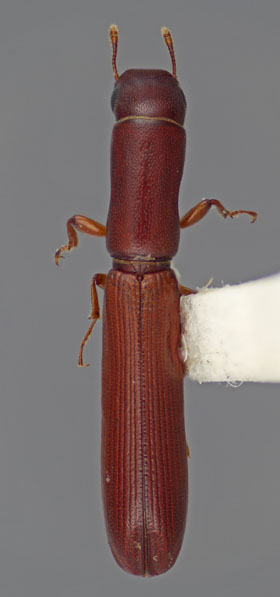 |
 Previous Genus Next Genus Previous Genus Next Genus 
Genus: Nematidium
Diagnostic Features
- Description: Body extremely elongate, cylindrical. Antennae 11-segmented with a distinct, 2-segmented club. Antennal setation sparse. Subantennal grooves present, distinct. Eyes well-developed, round, finely faceted, flush with head. Pronotal disc simple, pronotum longer than wide, lateral margins with large, shallowly depressed area. Procoxal cavities broadly closed. Metacoxae narrowly separated, separation less than metacoxal length. Elytral smooth, with finely impressed striae. Tarsal formula 4-4-4. Dorsal surface glabrous, densely and minutely punctured.
- Similar genera: The genus Nematidium is extremely distinctive and is not readily confused with other zopherid genera.
Known Distribution
- Southeastern (AL, FL, GA, SC, NC, TN) and South Central (LA) United States.
Probable Distribution
- South Central United States (MS).
Biology
- Nematidium filiforme had been collected at MV/UV lights. Adults and larvae of Nematidium have been found in the galleries of ambrosia beetles (Curculionidae: Platypodinae), and they are suspected to feed on the larvae of those beetles within the galleries (Ivie, 2002; Beeson, 1941; Roberts, 1977). This genus is a beneficial insect, attacking destructive wood boring beetles.
- Abundance: Uncommon.
North American Species (1)
Discussion
- This genus occurs worldwide, from South America to Indo-Malaysia.
Selected References
|
 |
 
Nematidium filiforme
© N.P. Lord |
© 2011-2015 Lord, N.P., Nearns, E.H., and K.B. Miller
The University of New Mexico and Center for Plant Health Science and Technology, USDA, APHIS, PPQ.
|


